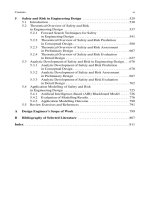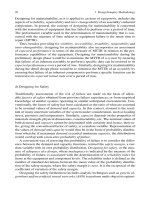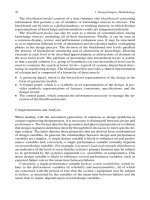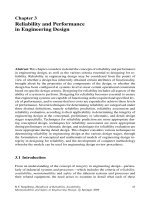Handbook of Reliability, Availability, Maintainability and Safety in Engineering Design - Part 10 pptx
Bạn đang xem bản rút gọn của tài liệu. Xem và tải ngay bản đầy đủ của tài liệu tại đây (94.07 KB, 10 trang )
3.2 Theoretical Overview of Reliability and Performance in Engineering Design 73
the reliability of relatively simple systems with series and parallel assemblies,to
estimations of the reliability of multi-state systems with random failure occurrences
and repair times (i.e. constant failure and repair rates) of inherent independent as-
semblies.
Reliability assessment in this context is considered during the preliminary or
schematic design phase of the engineering design process, with an estimation of the
probability that items of equipment will perform their intendedfunction for specified
intervals under stated conditions.
The most applicable methods for reliability assessment in the preliminary design
phase include concepts of mathematical modelling such as:
• Markov modelling:
To estimate the reliability of multi-state systems with constant failure and repair
rates of inherent independent assemblies.
• The binomial method:
To assess the reliability of simple systems of series and parallel assemblies.
• Equipment aging models:
To assess the aging of equipment at varying rates of degradation in engineered
installations.
• Failure modes and effects analysis/criticality analysis:
A step-by-step procedure for the assessment of failure effects and criticality in
equipment design.
• Fault-tree analysis:
To analyse the causal relationships between equipment failures and system fail-
ure, leading to the identification of specific critical system failure modes.
3.2.2.1 Markov Modelling (Continuous Time and Discrete States)
This method can be used in more cases than any other technique (Dhillon 1999a).
Markov modelling is applicable when modelling assemblies with dependent failure
and repair modes, and can be used for m odelling multi-state systems and common-
cause failures without any conceptual difficulty.
The method is more appropriate when system failure and r epair rates are con-
stant, as problems may arise when solving a set of linear algebraic equations for
large systems where system failure an d repair rates are variable. The method breaks
down for a system that has non-constant failure and repair rates, except in the case
of a few special situations that are not relevant to applications in engineering de-
sign. In order to formulate a set of Markov state equations, the rules associated with
transition probabilities are:
a) The p robability of more than one tr ansition in time interval Δt from one state to
the next state is negligible.
74 3 Reliability and Performance in Engineering Design
b) The transitional probability from one state to the next state in the time interval Δt
is given by
λ
Δt,where
λ
is the constant failure rate associated with the Markov
states.
c) The occurrences are independent.
A system state space diagram for system reliability is shown in Fig. 3.15. The state
space diagram represents the transient state of a system, with system transition from
state 0 to state 1. A state is transient if there is a positive probability that a system
will not return to that state.
As an example, an expression for system reliability of the system state space
shown in Fig. 3.15 is developed with the following Eqs. ( 3.5) and (3.6)
P
0
(t + Δt)=P
0
(t)[1 −
λ
Δt] , (3.5)
where:
P
0
(t) is the probability that the system is in operating state 0 at time t.
λ
is the constant failure rate of the system.
[1−
λ
Δt] is the probability of no failure in time interval Δt when the system is in
state t.
P
0
(t + Δt) is the probability of the system being in operating state 0 at time t +Δt.
Similarly,
P
1
(t + Δt)=P
0
(t)[
λ
Δt]+P
1
(t) , (3.6)
where:
P
0
(t) denotes the probability that the system is in failed state 0 in time Δt.
In the limiting case, Eqs. (3.5) and (3.6) become
lim
Δt→0
P
0
(t + Δt) −P
0
(t)
Δt
=
dP
0
(t)
dt
=
λ
P
0
(t) . (3.7)
The initial condition is that when
lim
Δt→0
P
1
(t + Δt) −P
1
(t)
Δt
=
dP
1
(t)
dt
=
λ
P
0
(t) , (3.8)
where: t = 0, P
0
(0)=1, and P
1
(0)=0.
Up
State 0
System operating
Down
State 1
System failed
λ
Fig. 3.15 System transition diagram
3.2 Theoretical Overview of Reliability and Performance in Engineering Design 75
Solving Eqs. (3.7) and (3.8) by using Laplace transforms
P
0
(s)=
1
s+
λ
(3.9)
and
P
1
(s)=
λ
s+
λ
. (3.10)
By using the inverse transforms, Eqs. (3.9) and (3.10) become
P
0
(t)=e
−
λ
t
, (3.11)
P
1
(t)=1− e
−
λ
t
. (3.12)
Markov modelling is a widely used method to assess the reliability of systems
in general, when the system’s failure rates are constant. For many systems, the as-
sumption of constant failure rate may be acceptable. However, the assumption of
a constant repair rate may not be valid in just as many cases.
This situation is considered later in Chapter 4, Availability and Maintainability
in Engineering Design.
3.2.2.2 The Binomial Method
This technique is used to assess the reliability of relatively simple systems with
series and parallel assemblies. For reliability assessment of such equipment,the
binomial method is one of the simplest techniques.
However, in the case of complex systems with many configurations of assem-
blies, the method becomes a trying task. The technique can be applied to systems
with independent identical or non-identical assemblies.
Various types of quantitative probability distributions are applied in reliability
analysis. The binomial distribution specifically has application in combinatorial re-
liability problems,and is sometimesreferredto as a Bernoulli distribution. The b ino-
mial or Bernoulli probability distribution is very useful in assessing the probabilities
of outcomes, such as the total number of failures that can be expected in a sequence
of trials, or in a number of equipment items.
The mathematical basis for the technique is the following
k
∏
i=1
(R
i
+ F
i
) , (3.13)
where:
k is the number of non-identical assemblies
R
i
is the ith assembly reliability
F
i
is the ith assembly unreliability.
76 3 Reliability and Performance in Engineering Design
This technique is better understood with the following examples:
Develop reliability expressions for (a) a series system network and (b) a parallel
system network with two non-identical and independent assemblies each.
Since k = 2, from Eq. (3.13) one obtains
(R
1
+ F
1
)(R
2
+ F
2
)=R
1
R
2
+ R
1
F
2
+ R
2
F
1
+ F
1
F
2
. (3.14)
a) Series Network
For a series network with two assemblies, the reliability R
S
is
R
S
= R
1
R
2
. (3.15)
Equation (3.15) simply represents the first right-hand term of Eq. (3.14).
b) Parallel Network
Similarly, for a parallel network with two assemblies, the reliability R
P
is
R
P
= R
1
R
2
+ R
1
F
2
+ R
2
F
1
. (3.16)
Since (R
1
+ F
1
)=1and(R
2
+ F
2
)=1, the above equation becomes
R
P
= R
1
R
2
+ R
1
(1−R
2
)+R
2
(1−R
1
) . (3.17)
By rearranging Eq. (3.17), we get
R
P
= R
1
R
2
+ R
1
−R
1
R
2
+ R
2
−R
1
R
2
R
P
= R
1
+ R
2
−R
1
R
2
R
P
= 1−(1−R
1
)(1−R
2
) . (3.18)
This progression series can be similarly extended to a k assembly system.
The binomial method is fundamentally a statistical technique for establishing
estimated reliability values for series or parallel network systems. The confidence
level of uncertainty of the estimate is assessed through the maximum-likelihood
technique. This technique finds good estimates of the parameters of a probability
distribution obtained from available data.
Properties of maximum-likelihood estimates include the concept of efficiency
in its comparability to a ‘best’ estimate with minimum variance, and sufficiency
in that the summary statistics upon which the estimate is based essentially contains
sufficient available data. This is a problem with many preliminary designs where the
estimates are not always unbiased, in that the sum of the squares o f the deviations
from the mean is, in fact, a biased estimate.
3.2 Theoretical Overview of Reliability and Performance in Engineering Design 77
3.2.2.3 Equipment Aging Models
A critical need for high reliability has particularly existed in the design of weapons
and space systems, wherethe lifetime requirement (5 to 10 years) has been relatively
short compared to the desired lifetime for systems in process designs such as nuclear
power plant (upto 30 years).In-service aging due to stringent operationalconditions
can lead to simultaneous failure of redundant systems, particularly safety systems,
with an essential need for functiona l operability in high-risk processes and systems,
such as in nuclear power plants (IEEE Standard 323-1974). Because it is the most
prevalent source of potential common failure mechanisms, equipment aging merits
attention in reviewing reliability models for use in designing for reliability and in
qualifying equipment for use in safety systems.
Although it is acknowledged that random failures are not likely to cause simulta-
neous failure of redundant safety systems, and this type of failure does not automat-
ically lead to rejection of the equipment being tested, great care needs to be taken
in understanding random failure in order to provide assurance that it is, in fact, not
related to a deficiency of design or manufacture. Aging occurs at varying rates in
engineering systems, from the time of manufacture to the end of useful life and,
under some circumstances, it is important to assess the aging processes.
Accelerated aging is the general term used to describe the simulation of aging
processes in the short time. At present, no well-defined accelerated aging method-
ology exists that may be applied generally to all process equipment. The specific
problem is determining the possibility of a link between aging or deterioration of
a component, such as a safety-related device, and operational o r environmental
stress. If such a link is present in the redundant configuration of a safety system,
then this can result in a common failure mode, where the common factor is aging.
Figure 3.16 below illustrates how the risk of common failure mode is influenced by
stress and time (EPRI 1974). The risk function is displayed by the surface, 0tPS. As
both stress and time-at-stress increase, the risk increases. P is the point of maximum
Fig. 3.16 Risk as a function of time and stress
78 3 Reliability and Performance in Engineering Design
common failure mode risk, which occurs when both stress and time are at a max-
imum. However, the risk occurring in and around point P cannot be evaluated by
either reliability analysis or high-stress exposure tests alone. In this region, it may
be necessary to resort to accelerated aging followed by design criteria conditions to
evaluate the risk. This requires an understanding of the basic aging process of the
equipment’s material.
Generally, aging information is found for relatively few materials. Practical
methods for the simulation of accelerated aging are limited to a narrow range of
applications and, despite research in the field, would not be practically suited for
use in designing for reliability (EPRI 1974).
3.2.2.4 Failure Modes and Effects Analysis (FMEA)
Failure modes and effect analysis (FMEA) is a p owerful reliability assessment tech-
nique developed by the USA defence industry in the 1960s to address the problems
experienced with complex weapon-control systems. Subsequently, it was extended
for use with other electronic, electrical and mechanical equipment. It is a step-by-
step procedure for the assessment of failure effects of potential failure modes in
equipment design. FMEA is a powerful design tool to analyse engineering systems,
and it may simply be described as an analysis of each failure mode in the system and
an examination of the results or effects of such failure modes on the system (Dhillon
1999a). When FMEA is extended to classify each potential failure effect according
to its severity (this incorporates documenting catastrophic and critical failures), so
that the criticality of the consequence or the severity of failure is determined, the
method is termed a failure mode effects and criticality analysis (FMECA).
The strength of FMEA is that it can be applied at different systems hierarchy
levels. For example, it can be applied to determine the performance characteristics
of a gas turbine p ower-generating process or the functional failure probability of its
fire protection system, or the failure-on-demand probability of the duty of a single
pump assembly, down to an evaluation of the failure mechanisms associated with
a pressure switch component. By the analysis of individual failure modes, the effect
of each failure can be determined o n the operational functionality of the relevant
systems hierarchy level. FMEAs can be performed in a variety of different ways
depending on the objective of the assessment, the extent of systems definition and
development, and the information available on a system’s assemblies and compo-
nents at the time o f the analysis. A different FMEA focus may dictate a different
worksheet format in each case; nevertheless, there are two basic approaches for the
application of FMEAs in engineering design (Moss et al. 1996):
• The functional FMEA, which recognises that each system is designed to perform
a number of functions classified as outputs. These outputs are identified, and the
losses of essential inputs to the item, or of internal failures, are then evaluated
with respect to their effects on system performance.
3.2 Theoretical Overview of Reliability and Performance in Engineering Design 79
• The equipment FMEA, which sequentially lists individual equipment items and
analyses the effect of each equipment failure mode on the performance of the
system.
In many cases, a combination of these two approaches is employed. For example,
a functional analysis at a major systems level is employed in the initial functional,
‘broad-brush’ analysis during the preliminary design phase, which is then followed
by more detailed analysis of the equipment identified as being more sensitive to
the range of uncertainties in meeting cer tain design criteria during the detail design
phase.
a) Types of FMEA and Their Associated Benefits
FMEA may b e grouped under three distinct classifications according to application
(Grant Ireson et al. 1996):
• Design-level FMEA
• System-level FMEA
• Process-level FMEA.
Design-level FMEA The intention of this type of FMEA is to validate the design
parameters chosen for a specified functional performance requirement. The advan-
tages of performing design-level FMEA include identification of potential design-
related failure modes at system/sub-system/component level; identification of im-
portant characteristics of a given design; documentation of the rationale for design
changes to guide the d evelopment of future designs; help in the design requirement
objective evaluation; and assessment of design alternatives during the preliminary
and detail phases of the engineeringdesign process. FMEA is a systematic approach
to reduce criticality and risk, and a useful tool to establish priority for design im-
provement in designing for reliability during the preliminary design phase.
System-levelFMEA This is the highest-levelFMEA that is performed in a system s
hierarchy, and its purpose is to identify and prevent failures related specifically to
systems/sub-systems during the early preliminary design phase of the engineering
design process. Furthermore, this type of FMEA is carried out to validate that the
system design specifications will, in fact, reduce the risk of functional failure to the
lowest systems hierarchy level during the detail design phase. A primary benefit of
the system-level FMEA is the identification of potential systemic failure modes due
to system interaction with other systems in com plex integrated designs.
Process-level FMEA This identifies and prevents failures related to the manufac-
turing/assembly process for certain equipment during the construction/installation
stage of an engineering design project. The benefits of this detail design phase
FMEA include identification of potential failure modes at equipment level, and the
development of priorities and documentation of rationale for any essential design
changes, to help guide the manufacturing and assembly process.
80 3 Reliability and Performance in Engineering Design
b) Steps for Performing FMEA
FMEA can be performedin six steps based on the key concepts of systems hierarchy,
operations, functions, failure mode, effects, potential failure and prevention. These
steps are given in the following logical sequence (Bowles et al. 1994):
FMEA sequential steps
• Identify the relevant hierarchical levels, and define systems and equipment.
• Establish ground rules and assumptions, i.e. operational phases.
• Describe systems and equipment functions and associated functional blocks.
• Identify possible failure modes and their associated effects.
• Determine the effect of each item’s failure for every failure mode.
• Identify methods for detecting potential failures and avoiding functional failures.
• Determine provision for design changes that would prevent functional failures.
c) Advantages and Disadvantages of FMEA
There are many benefits of performing FMEA, particularly in the effective analy-
sis of complex systems design, in comparing similar designs and providing a safe-
guard against repeating the same mistakes in future designs, and especially to im-
prove communication among design interface personnel (Dhillon 1999a). However,
an analysis of several industry-conducted FMEAs (Bull et al. 1995) showed that
the timescale involved in properly developing FMEA often exceeds the prelimi-
nary/detail design phases. It is common that the results from an FMEA can be de-
livered to the client only with or, possibly, even after the development o f the system
itself. An automated approach is therefore essential.
3.2.2.5 Failure Modes and Effects Criticality Analysis (FMECA)
The objective of criticality assessment is to prioritise the failure modes discovered
during the FMEA on the basis of their effects and consequences, and likelihood of
occurrence. Thus, for ma king an assessment of equipm ent criticality during prelim-
inary design, two commonly used methods are the:
• Risk priority number (RPN) technique used in general industry,
• Military standard technique used in defence, nuclear and aerospace industries.
Both approaches are briefly described below (Bowles et al. 1994).
a) The RPN Technique
This method calculates the risk priority number for a component failure mode using
three factors:
3.2 Theoretical Overview of Reliability and Performance in Engineering Design 81
• Failure effect severity.
• Failure mode occurrence probability.
• Failure d etection probability.
More specifically, the risk priority number is computed by multiplying the rankings
(i.e. 1–10) assigned to each of these three factors. Thus, mathematically the risk
priority number is expressed by the relationship
RPN =(OR)(SR)(DR), (3.19)
where:
RPN = the risk priority number.
OR = the occurrence ranking.
SR = the severity ranking.
DR = the detection ranking.
Since the three factors are assigned rankings from 1 to 10, the RPN will vary from 1
to 1,000. Failure modes with a high RPN are considered to be more critical; thus,
they are given a higher priority in comparison to the ones with lower RPN. Specific
ranking values used for the RPN technique are indicated in Tables 3.4, 3.5 and 3.6
for failure detection, failur e mode occurrence probability, a nd failure effect severity
respectively (AMCP 706-196 1976).
Table 3.4 Failure detection ranking
Item Likelihood of detection and meaning Rank
1 Very high—potential design weakness will be detected 1, 2
2 High—good chance of detecting potential design weakness 3, 4
3 Moderate—possible detection of potential design weakness 5, 6
4 Low—potential design weakness is unlikely to be detected 7, 8
5 Very low—potential design weakness probably not detected 9
6 Uncertain—potential design weakness cannot be detected 10
Table 3.5 Failure mode occurrence probability
Item Ranking Ranking meaning Occurrence Rank
term probability value
1 Remote Occurrence of failure is quite unlikely <1in10
6
1
2 Low Relatively few failures are expected 1 in 20,000 2
1in4,000 3
3 Moderate Occasional failures are expected 1 in 1,000 4
1in400 5
1in80 6
4 High Repeated failures will occur 1 in 40 7
1in20 8
5 Very high Occurrence of failure inevitable 1 in 8 9
1in2 10
82 3 Reliability and Performance in Engineering Design
Table 3.6 Severity of the failure mode effect
Item Failure effect Severity category description Rank
severity value
1 Minor No ef fect on system performance, and the failure
may not even be noticed
1
2 Low The occurrence of failure will cause only a slight
dissatisfaction if observed (i.e. potential loss)
2, 3
3 Moderate Some dissatisfaction will be caused by failure 4–6
4 High High degree of dissatisfaction will be caused by failure
but the failure itself does not involve safety or even
a non-compliance to safety regulations
7, 8
5 Very high The failure affects safe item operation, and involves
significant non-compliance with safety regulations
9, 10
b) The Military Stan dard Technique
This technique is used in military defence, aerospace and nuclear industries, to pri-
oritise the failure modes of the item under consideration so that appropriate cor-
rective measures can be undertaken (MIL-STD-1629). The technique requires the
categorisation of the failure mode effect severity and then the development of a crit-
ical ranking. Table 3.7 presents classifications of failure mode effect severity. In
order to assess the likelihood of a failure mode occurrence, either a qualitative or
a qu antitative approach can be used. The qualitative method is used when there are
no specific failure rate data. In this approach, the individual occurrence probabilities
are grouped into distinct, logically defined levels that establish the qualitativefailure
probabilities. Table 3.8 presents occurrence probability levels (MIL-STD-1629).
A criticality matrix is developed as shown in Fig. 3.17, for identifying and com-
paring each failure mode to all other failure modes with respect to severity. The
criticality matrix is developed by inserting values in matrix locations denotin g the
severity classification, and either the criticality number K
i
for the failure modes of
an item, or the occurrence level probability. The distribution of criticality of item
failure modes is depicted by the resulting matrix, and serves as a useful tool for
assigning design review priorities.
The direction of the arrow originating from the origin, shown in Fig. 3.17, in-
dicates the increasing criticality of the item failure, and the hatching in the figure
shows the approximate desirable design region. For severity classifications A and B,
the desirable design regio n has low occurrence probability or criticality number. On
the other hand, for severity classifications C and D failures, higher probabilities
of occurrence can be tolerated. Nonetheless, failure modes belonging to classifi-
cations A and B should be eliminated altogether or at least their probabilities of
occurrence be reduced to an acceptable level through design changes. The quanti-
tative approach is used when failure m ode and probability of occurrence data are
available. Thus, the failure mode critical number is calculated using
K
fm
= F
θλ
T , (3.20)









